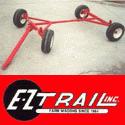 |
 |

|
|
|
National & World Ag News Headlines |
 |
Compare Alternative Feed Value and Prices
USAgNet - 03/21/2019
Cattle producers may be looking for alternative feed to stretch their hay supplies because of this winter's persistent cold temperatures and heavy snowfall.
Alternative feeds are available, but producers should compare prices and the nutrient content of the feeds to see which ones best meet their cattle's needs, according to Karl Hoppe, North Dakota State University Extension livestock systems specialist at the
Carrington Research Extension Center.
"Determining the relative value of alternative feeds can be a cost-saving strategy," he says. "Relative value is calculated from the value of the nutrients in the alternative feed, as compared with a common feed."
The first step is to obtain a feed analysis of the alternative feed. A laboratory analysis report for the feed is best, but the NDSU Extension publication "Alternative Feeds for Ruminants" (https://tinyurl.com/AlternativeFeed) lists the nutrient content of conventional
and alternative feeds.
The second step is to do a price and feed analysis for a commonly available feed.
The most expensive component of a livestock diet is energy, Hoppe says. Energy is measured as megacalories of net energy or as total digestible nutrients (TDN). The price per pound of energy is calculated by adjusting the feed price to a 100 percent
dry-matter basis.
For example, corn priced at $3.25 per bushel (56 pounds) and 14 percent moisture would be $0.0674 per pound of corn on a dry-matter basis, or ($3.25 Ã- 56) Ã- (100 - 14) x 100. Because corn is 90 percent TDN on a dry-matter basis, the cost per
pound of energy would be calculated as: $0.0674 Ã- .90 = $0.0749 per pound of energy.
The relative value of alternative feeds can be priced according to the energy price of corn. Use wheat middlings as an example.
If wheat middlings are 83 percent TDN and 10 percent moisture, they would be $111.90 per ton, or $0.0749 x .83 x [(100 - 10) x 100] x 2,000. Therefore, the energy costs of corn at $3.25 per bushel are comparable to wheat middlings at $111.90 per ton.
However, if the feed test shows 70 percent TDN, then the math is: $0.0749 x .70 x [(100 - 10) x 100] x 2,000 = $94.37 per ton. At the lower energy content, the feed is worth only $94.37 per ton when corn is $3.25 per bushel.
If the ration needs additional protein, then a credit for the protein should be added.
For example, wheat middlings have a higher crude protein percentage than corn, so a credit for the additional protein should be added (if the feed ration needs more protein). The value of the additional protein is calculated relative to a protein supplement such as
canola meal (assumed price of $205 per ton, 13 percent dry matter and 36 percent crude protein). The calculation would be: $205 Ã- 2,000 Ã- (100 - 13) x 100 Ã- 36 percent crude protein = $0.327 per pound of added crude protein.
Because wheat middlings are 18 percent crude protein and corn is 9.8 percent, the additional crude protein value is calculated as: 2,000 x (.18 - .09) x [(100 - 10) x 100 moisture] x $0.327 = $52.97 per ton. If the diet needs additional protein, then the relative
value of the wheat middlings can be increased an additional $52.97 per ton when canola meal is $205 per ton.
A computer can do this math quickly, and a spreadsheet is available at https://tinyurl.com/FeedValueCalculation. Click on "Combined Feed Value and Protein and Energy Calculator."
"Be sure to input current feed prices," Hoppe advises.
For recent feed prices, go to https://tinyurl.com/CarringtonRECLivestock. Click on "Co-product Feeds in North Dakota - February 2019."
|
 |


|
 |
|
Copyright © 2024 - Farms.com. All Rights Reserved. |
 |
|